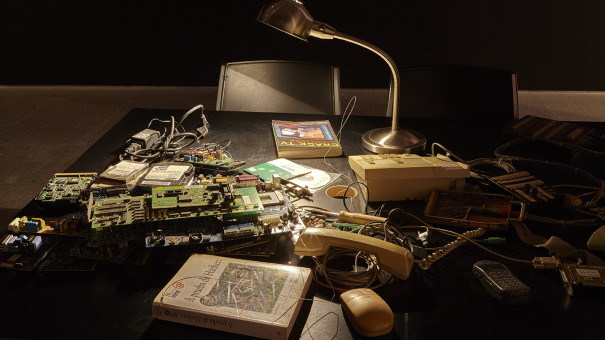Tag: Operating System
-

THE EXPLOIT: DANIEL G. ANDÚJAR
A*Desk 02 FEBRUARY 2015 JUANJO SANTOS The first solo exhibition of the year at the Museo Nacional Centro de Arte Reina Sofía is “ Operating System”, by Daniel García Andújar. A large selection of earlier works is being shown alongside new creations that continue to explore the link between new technologies and society, intervening between…
-
Daniel García Andújar. Operating System. January 20. Museo Nacional Centro de Arte Reina Sofía
Daniel García Andújar. Operating System January 21 – May 4, 2015. Sabatini Building, Floor 3, Zones E and F Organized by: Museo Nacional Centro de Arte Reina Sofía Curatorship: Manuel J. Borja-Villel Artists: Daniel García Andújar Martes 20 Enero 2015: 12.00 Press 13:00 Private visit 20.00 Official opening http://www.museoreinasofia.es/en/exhibitions/daniel-garcia-andujar-operating-system Daniel García Andújar (Almoradí, 1966) is…
-
Videoarte hecho en España
perez-rey.blogspot.com Desde hoy, 12 de febrero, se puede ver en el Centro de Arte Complutense la exposición Videoarte hecho en España. En esta exposición queda patente el impulso del videoarte en el escenario cultural español como tendencia artística paralela a la consolidación y universalización de los medios de comunicación de masas. Los videoartistas utilizan los…
-
Free Software on the Surface, Behind the Screen and in a Cultural Kaleidoscope: X-Devian.
The New Technologies To The People® System By Jacob Lillemose In 1999, when the art and technology festival Ars Electronica awarded The Golden Nica, first prize in the ”.net” category, to the programmer Linus Torvalds for his development of the Linux operating system, it was pointing in general to the relationship between free software and…
-
Crítica de la simulación de las libertades
Álvaro de los Ángeles Daniel G. Andújar. Individual Citizen Republic Project: EL SISTEMA. Technologies To The People – Espai ZER01, Olot, diciembre 2003 – febrero 2004 La cita que antecede a los Comentarios sobre la Sociedad del Espectáculo, de Guy Debord, bien podría tomarse como una de las claves en la estrategia de la resistencia,…
-
Individual Citizen Republic ProjectTM: El Sistema
El ciclo Dimensiones Variables es un proyecto que pretende explorar la paradójica inclinación que afecta a ciertas prácticas artísticas contemporáneas, las cuales parecen debatirse entre dos territorios de interpelación en apariencia antagónicos: por una parte, el impulso de acotar el espacio social para analizar sus estrategias, posicionarse respecto a sus dinámicas y actuar de manera…
